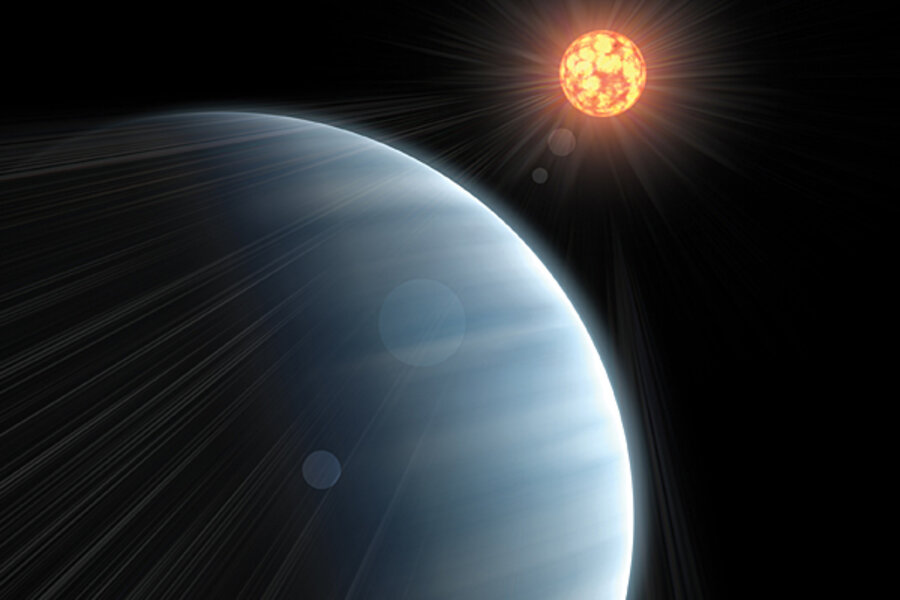'Milestone' in bid to sniff atmosphere of a 'super Earth' light-years away
Loading...
Some 40 light years from Earth, well within the sun's galactic "neighborhood," a planet nearly three times the size of Earth orbits a dim, low-mass star much smaller than the sun.
Recent observations indicated that the planet, a so-called "super Earth," has an atmosphere, and scientists Wednesday were applauding reports of the first measurements aimed at determining the kind of atmosphere the planet has – measurements that were taken despite the planet's distance, the star's dimness, and its relatively small size. It was also the first time ever that measurements have been taken of a super Earth's atmosphere.
At this stage, "process of elimination" is the operative phrase. In the results reported Wednesday, a team of astronomers led by Jacob Bean at the Harvard-Smithsonian Center for Astrophysics in Cambridge, Mass., use their data to rule out one of three broad types of atmosphere that others had suggested the planet could have.
"Even with these new measurements, we can't say yet what that atmosphere is made of," said Dr. Bean. Still, the ability to rule out one possibility represents "a milestone on the road toward characterizing these worlds," he added in a prepared statement.
Atmosphere indicated by planet's low density
Last December, another team of astronomers announced that they'd discovered the planet, dubbed GL 1214b. Data they gathered watching the star's light dim and brighten as the planet crossed in front of it indicated a planet with nearly seven times Earth's mass. Yet when the team estimated the planet's density, it was too low for a planet of its size and mass if the planet was made entirely from rock and water ice.
Modeling results suggested that the planet itself was smaller than the observed radius, with the rest of the volume the team measured taken up with an atmosphere, perhaps consisting of steam. Other models pointed to an atmosphere made largely of hydrogen and helium gas. Still others suggested a haze- or cloud-shrouded atmosphere like Venus's or like the atmosphere blanketing Saturn's moon Titan.
The results reported Wednesday in the journal Nature suggest that scientists can drop the hydrogen-helium possibility.
Interest in characterizing the atmospheres of extrasolar planets – particularly those beginning to approximate Earth's size and mass – stems not only from a desire to fine tune the technologies that allow for such studies. A planet's atmosphere also can yield clues about its history.
For instance, the team notes that if the atmosphere is essentially steam, the planet likely would have had a high water-ice content at some point, implying that the planet could have first formed beyond the system's "snow line," a rough distance from the sun where compounds such as water, methane, and ammonia freeze out as ices.
The researchers gathered their data using the European Southern Observatory's Very Large Telescope in Chile. They measured the spectra from the star as the planet passed in front of it. The brightness of the star's spectrum varies with the light's wavelength as the starlight encounters different molecules in the planet's atmosphere. Thus the molecules in effect imprint their signatures on the starlight.
Hydrogen ruled out
The planet's apparent size and density clearly point to the presence of an atmosphere. However the team saw no telltale variation in the star's spectrum that would reveal the atmosphere's composition. That allowed them to rule out the hydrogen explanation.
The planet is so close to its host star, that an atmosphere made up of hydrogen, a light gas, would be heated and expand, forming an extended envelope around the planet. Thus any starlight passing through would encounter lots of hydrogen molecules, making the hydrogen relatively easy to spot.
But the absence of evidence is not necessarily the evidence of absence.
The researchers posit that the atmosphere could exist in a dense layer relatively close to the planet's surface, a condition that would yield a very weak effect on the spectrum compared with an extended envelop of hydrogen. Or, they add, any spectral fingerprints could be too faint to pick up because clouds or haze block the light at the wavelengths the team used in its observations.
The Hubble Space Telescope should be able to help solve the mystery of GL 1214b's atmosphere because it operates at wavelengths of light that may overcome some of the limitations the team faced with its ground-based spectroscope, notes Drake Deming, a researcher at NASA's Goddard Space Flight Center in Greenbelt, Md. He points out that time on the orbiting observatory already has been alloted for studying GL 1214b.
And the James Webb Space Telescope, which currently is slated for launch in 2014, should be able to characterize the planet's atmosphere in still greater detail, he notes.





